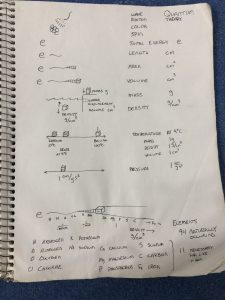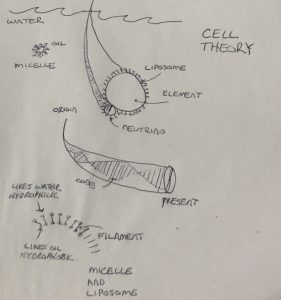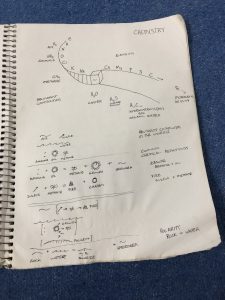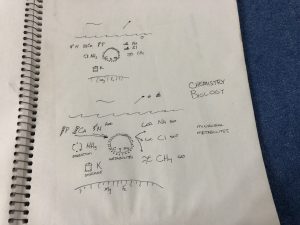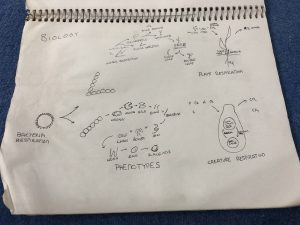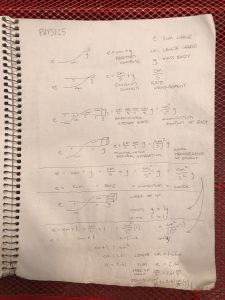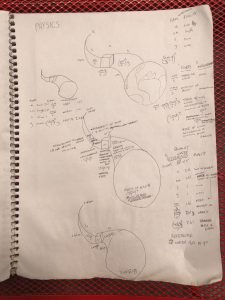Hey folks,
I’m in Puebla Mexico. It was a quiet walk from Pachuca to Puebla. Lots of thinking, planning. I’ll offer a brief story of the trip and then share what I’m thinking.
I camped in an abandoned house a km down the road from where I sent the last email. It’s chilly at night, high elevation, it was good to have concrete walls. Next day had pork tacos for lunch. Ladies asked what I was doing. They gave me lunch for free and provided a drink and fruit for the road. Muy buena gente.
Walked on. Got a flat. Bare tread. Walked 5km to next town. Got new tires. Repaired tire. Left plaza, same tire goes flat. Earlier wind blew the tarp and chair out of the cart. Walked back 5km to look for tarp and chair. Didn’t find them. Arrived to where I got the flat, a truck mechanic. When I arrived, the owner was closing up. We met. He asked my story.
What’s your meta, he asked. Your goal.
Surviving, I said. He didn’t accept that.
Wait wait you’re walking from Georgia to somewhere in South America, what’s you’re meta?
Alright, I want to remind humans that money comes from the earth. And they don’t have to leave their home or their country to get it. That’s my meta.
He paused. He said okay, there’s a room with a mattress over there if you want to stay here for the night.
Thanks, I said. He got in the truck with his two sons and rode off.
Had a good meal and a good rest. I tried to fix my tires no luck, tire key broke. I’m not the greatest mechanic. Decided to walk 25km to the next town, Ciudad de Sahagún, to get it fixed. Rolling hills all the way. Passed through a town called Tlanalapa. A large corn field separated Tlanalapa and Ciudad de Sahagún. I took a nap under a tree in the field and then shuffled through a sandy path and arrived later at a bike shop.
Cesar and his friend David put on new tires and new tubes. Only asked 50 pesos. Amazing. Cool guys. Really clutch. Apparently it’s not good to have an old spare tire inside a tire. The rubber rubs off onto the tube. After all these miles, I’m still figuring out the basics.
Stayed at a hotel in town, washed up bathed up charged up rested up, next morning met good folks eating fried tacos under a tarp in the market. Nice market area in Sahagún, lots of easily walkable roads. Got a local SIM card on the way out of town..Got more data now. Yeah I changed phone numbers. Please holler at me if you want the new number.
Walked along south. Large farms growing corn and grass on both sides of the road. Camped near a creek bed. Tried out a new tarp, works good. 3m x 4m is a good fit to wrap the cart and myself.
Met a friendly couple next day, Teresa and Jesus at lunch in the next town. Amazing plate of steak salad beans and tortillas. They provided me a 5gallon jug and wished me well.
More rolling hills. Long views, valleys. I got on the interstate highway by accident and seemed to bypass towns. Roads and vehicles for days.
Camped in a field of tall corn, quiet place, a good distance from the highway, a house nearby had flowers blooming. Next night I camped on a long raised truck ramp, next evening a corn field. And finally arrived in Puebla, and wheeled the cart through the Sunday afternoon market rush. I opted to stay at another hotel for the night.
It was nice to have some quiet days to process the trip and what I’m doing. In this time, I formed a new plan. I plan to make a hydroponic system for the cart. Similar to the system I made when I stayed in West Virginia years ago. Hydroponics fed with food waste. I have space for 8 plants and a gallon of water to cycle through the roots. It could be enough for a small model. I may buy seeds and see if I can sell them at town parks. Organic farm starter pack.
I’ll share more about this in a few weeks if and when the new cart design comes together.
In the last few weeks, I also thought more about science. Here’s where I’m at:
SCIENCE
Science provides theories on the invisible web of the physical world. It describes how plants and creatures formed and by what metrics they move around the earth.
Science involves generally four areas. Quantum and cell theory describe how light forms into measurable elements. Chemistry describes physical properties of these elements and how they bond together to form compounds. Biology describes how life forms from elements and evolves into organisms of increasing complexity. And physics describes the metrics by which elements and organisms exist and move around.
QUANTUM THEORY
Quantum theory describes how waves of light enter earth’s atmosphere and form elements. It’s the study of life at the smallest measurable scale.
WAVE
Light waves glide through space. When they enter earth’s atmosphere, waves transform into a photon, a massless particle.
COLOR
The particle passes through a tube, called a gluon, and receives a color charge. Imagine a color wheel with all imaginable colors on it.
SPIN
Then the particle passes through a quark where it receives character, in the form of spin. There are six flavors of quarks: top bottom charm strange truth and beauty. I imagine these flavors are like the aspects of our character, our personality. Each flavor adds a spin to the particle, a fraction between -1 and 1. When the particle leaves the Quark, it has a spin equal to e times this fraction, where e is the total amount of energy in the particle.
CHARGE
After the photon receives a color and a spin, the particle becomes a lepton and receives a charge. The amount of charge determines the lepton flavor. Lepton flavors are Pion, the lightest particle, muon and tau, each increasing in charge.
QUARKS AND LEPTONS
Quarks and gluons are fixed charges. They are determined before we enter this world, like the location where we are born or what we look like. Leptons however are up to us to determine their charge. I think of leptons as the amount of effort we put into each day, hour and moment.
SUM
The sum of quarks and leptons is equal to the total energy in the particle. This is equal to e, the spin before a fraction is applied and the charge before a charge is applied.
As particles gain mass, particles lose charge. Mass and length of charge always equal total energy.
LENGTH CM
The length of the lepton charge, Ray. Measured in cm, centimeters.
AREA CM^2
Area of charge indicating length growing at a steady rate over time. And two options emerging as indicated by lines moving up and down. When particles are measured, they can be seen as particles or waves, point or a field, a location or a trajectory. This describes the duality of observed natural phenomena.
VOLUME CM^3
When a particle gains a third dimension, it gains volume, a measurable body in our physical world. We found we could place this body in water and determine its volume based on the amount of water displaced.
REFERENCE
It seems water has often been used as a reference point to measure density. Water is most dense at 4 degrees, just above freezing. One cubic centimeter is used as a reference point for volume.
TEMPERATURE
Freezing point of water 0 degrees
Boiling point of water 100 degrees
Elements have varying freezing and boiling points.
Standard temperature equals 4 degrees. Temperature at which water is most dense.
PRESSURE
Equal to 1 cm/gs2 for standard pressure
All elements have a density at standard temperature (4º) and pressure (1cm/gs^2).
DENSITY
Density is determined as elements rise or sink in water. A list of elements may be arranged by density.
MASS
Mass may be determined by the weight of an object in air. How fast it falls toward earth.
ELEMENTS
photon spin charge —> element
After a spin and charge are applied, the particle gains a mass and physical properties and is called an element.
Using 1cm3 of water as a reference point we can determine densities of common elements.
There are 94 naturally occurring elements on earth. 11 elements are necessary for life. Elements listed by density (g/cm3):
(1/100,000 density)
- Hydrogen
- Nitrogen
- Oxygen
- Chlorine
(1/1000 density)
- Potassium
- Sodium
Water = 1g/cm3 at 4degress Celsius
(1-3 density)
- Calcium
- Magnesium
- Phosphorus
- Sulfur
- Carbon
- Silicon
COMPOUNDS
Chemical compounds form based on magnetic properties of elements. Magnetic properties of elements involve their color spin charge and properties.
CELL THEORY
MICELLES
Let’s imagine a pool of water with tiny drops of oil floating on top. Tiny drops of oil in water with no charge are called micelles. Now imagine a light wave approaching earth, receiving a color spin and charge and finding a body in micelles.
LIPOSOMES
Light fills micelles and create dense masses called liposomes. Liposomes are oil-based membranes surrounding a charged light particle.
FILAMENTS
Micelles and Liposomes are described to be composed of tiny filaments. One end of the filament likes water, the other end likes oil. Oil is less dense than water and floats. Elements in water may be measured based on a reference point of water.
NEUTRINO
When a particle reaches its max charge, it begins to decay. At which moment, the next photon fills the tube. Neutrinos are the next photon. They enter this world the moment a current particle begins to decay. Neutrinos are like baby photons. They are exponentially smaller in mass compared to a charged particle. Neutrinos record decisions made by the particle and carries messages from source, the origin of the light particle.
I imagine a neutrino to function like a propellor spinning in the present moment and creating a double helix body like dna, as a storage of recorded data, and communicating with the source or origin of the particle like rna.
This whole process.. from photon to charged lepton.. lasts a fraction of a second. It then decays and the neutrino enters as the next lepton.
EXTRA BIOLOGICAL TERMS
This theory proposes there may be superfluous biological terms proposed in 20th century cell theory.
NO DNA RNA
This theory proposes there is no proton or neutron, and therefore no DNA or RNA in cells. The neutrino performs the role of writing code (DNA) and sending and receiving messages (RNA).
NO NUCLEUS CYTOPLASM
This theory also proposes there is no cytoplasm and no nucleus, the whole element contains properties of the nucleus.
NO MITOCHONDRIA
There may also be no mitochondrial matrix, location of atp/adp exchange, cell respiration. Respiration may happen within the whole cell and in the organs of more complex bodies rather than in the outer membrane.
NO ELECTRON
There may also be no electron, no floating orbital around an imaginary nucleus. Chemical bonds, typically a complex algorithm involving electrons, may be simply the magnetic attraction of elements based on their color, spin, charge and physical properties of elements and organisms. Chemical bonds may be similar to the reasons why people are attracted to other people, a complex combination of all things in our character.
CHEMISTRY
HYDROGEN COMPOUNDS
Hydrogen is the most abundant element in the universe. Hydrogen bonds with elements to form compounds. Here are some of the most abundant compounds on earth:
Air H2
Water H2O
Ammonia NH3
Hydrogen sulfide H2S
Methane CH4
Hydrocarbons (C_H_)
Organic matter
CHEMICAL REACTIONS
Elements and compounds may bond together and cause chemical reactions. Here are common chemical reactions: .
GROWTH
Ammonia + oil (hydrocarbons) = Methane + Growth + hydrogen
Ammonia is a catalyst for metabolic reactions in organisms. And oil, carbon, is the material body of organisms.
Organisms digest food, gain energy to growth, and release methane, gas into the atmosphere. And they produce hydrogen, which helps regenerate abundant compounds, water air etc.
FIRE
Sulfur + methane = Fire + carbon
Sulfur is flammable. Methane is a flammable gas, fuel. Together they make fire, heat, and leaves carbon, the body of lifeforms.
POLARITY
Another way hydrogen is reproduced on earth is from a reaction between water and rock. Some theories say the earth once began as an rock made of olivine, a volcanic rock made of magnesium and iron. With heat, water penetrates separates the magnesium from the iron, creating magnetic polarity. This process is called Exothermic Serpentinization. Polarity of rocks caused from heat + water + rocks.
MICROBIAL METABOLITES
Organisms
Living species are composed of at least eleven elements. These elements and compounds are necessary for life. Listed on the sketch are the functions of each necessary element.
To grow, species metabolize food, They consume, process and release elements and compounds from around them. Metabolism is how organisms breathe and grow. Called microbial metabolites and organisms, they range from simple to complex life forms. Bacteria is a simple microbial metabolite.
Functions of elements and compounds of organisms
Hydrogen H
air, bonds with many elements
H2. Air
Nitrogen Food
ammonia nh3 digestion
H2O water
Chlorine. Salt
Potassium. Energy storage
Sodium Salt
Calcium. Food
Magnesium. Magnetism
Phosphorus. Food
Sulfur. Flammability
Carbon. Structure
Silicon Shell
BIOLOGY
PHENOTYPE
Listed are creatures by phenotype generally in order of when they evolved. Phenotypes are the observable constitution of living species, microbial metabolites.
Living species evolved from stacks of cells called flagellum, single and double strand shaped organisms. There are unikonta and bikonta flagellum, one and two fiber organisms. Creatures evolved from unikonta, plants evolved from bikonta. This list describes evolving phenotypes of creatures and plants.
BACTERIA
FLAGELLUM
BIKONTA
Two filaments, one feeds the other. Plants evolved from bikonta. Listed are evolving phenotypes.
Phenotype Metabolite.
Water respiration algae
Silica skeleton Protozoa
Chlorophyll
—>. Spore producing mosses
Vascular system ferns
Seed producing
—> single leaf grasses
—-> double leaf. marigolds
PLANT RESPIRATION
Photosynthesis absorbs water sunlight and co2 makes carbs and sugars sends to roots. Roots feed bacteria Protozoa eat bacteria and release ammonia. Ammonia used in photosynthesis to grow the plant. Releases oxygen, hydrogen.
UNIKONTA
Unikonta is one filament one side just feed the other. Creatures evolved from unikonta.
Listed are phenotypes and examples of each:
Phenotype. Metabolite.
Unikonta Amoeba
Organ. Jellyfish
Mouth. Worm
Anus. —> shell. Snail
—> one foot. Arthropod
externsl skeleton Centipede
one foot shell shrimp
six feet insects
eight feet spiders
Gills Sea squirts
Vertebrae Lamprey
Lungs Lungfish
Jaws. Sharks rays
Internal Skeleton Coalecanth
Legs. Amphibians
—> Dinosaurs
—> Wings. Birds
Egg Reptiles
Placenta Humans
CREATURE RESPIRATION
Citric acid and Urea cycle
The citric acid cycle transforms food to make energy for the body. During this process, a variety of acids and sugars are applied to food to make energy for the body, The cycle releases salt carbon and urea. Urea passes through urea cycle to be recycled into ammonia. In complex creatures, these processes happen in the stomach and kidneys.
PHYSICS
e equals total sum of energy
cm is the length of the charge.
cm^2 is the area of the charge
e=cm+g
Add combine to make whole sum
e. Sum Whole
cm. Charge Length
g. Material Mass
e=cm/s+g
Divide Contained one within another
s. Seconds. Time.
cm/s. Speed. Distance to time ratio
e=(cm/s)^n
^n. Exponential Steady rate
cmg/s. Momentum. Motion of body
(g)(cm/s)^2
Multiply Natural generation
Work Transference of energy
= (g)(cm/s)^2
EQUATIONS
e= cm+g = cm/s+g = (cm/s)^n = (cm/s)^2*g
Total energy (e) equals all equations
REFERENCE
Water at 4 degrees
1g
1s
e = cm+1 = cm/1+1 = (cm/1)^n = (cm/s)^2*1
e = cm+1 n=2 —-> cm^2
e = cm+1 = cm^2
cm = 1.61 (length of charge per 1 second)
1.61cm/s (speed of light)
2.61cm/s^2 *g (amount of work done to particle, acceleration of gravity)
These theories redefine speed of light and gravity constants. The units we use today for the speed of light is the speed of light in a vacuum. The unit proposed is the speed of light in a medium. Medium is nature. It’s slower.
For gravity, the 9.8m/s^2 estimation is mainly for planets. It has little relevance to humans. Gravity =2.6cm/s^2 (times mass of object) seems more relevant to humans.
Okay. That was some pretty heavy material. Thanks for hanging with me. I very humbly offer this information. Overall I’m just looking for things to do. I like to learn and arrange material in simple forms. Hope this info was accurate and clear. I may write a short book or create a course sometimes if the material is ready. Feel free to respond with comments.
From here, I plan to walk to Oaxaca and get this mobile garden going.
Thanks for reading.
See ya next time
Brian
